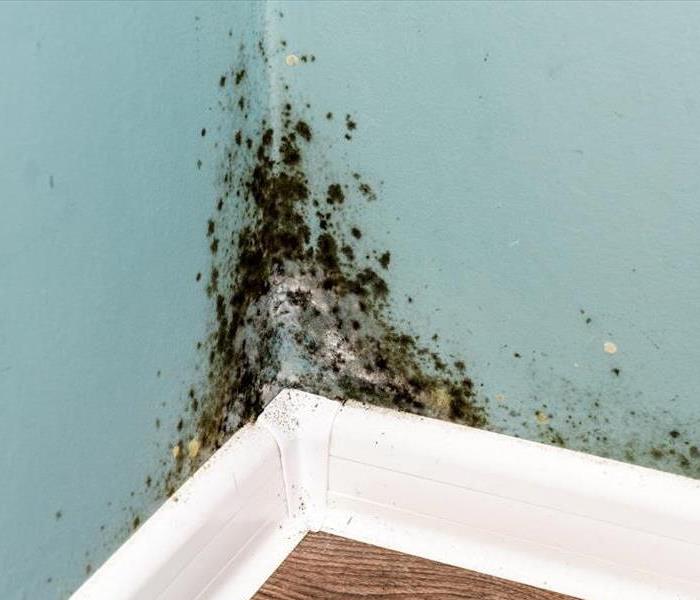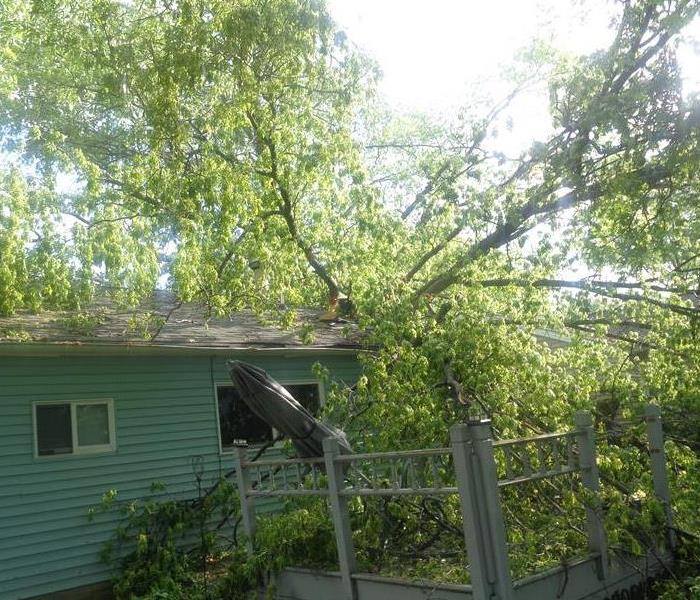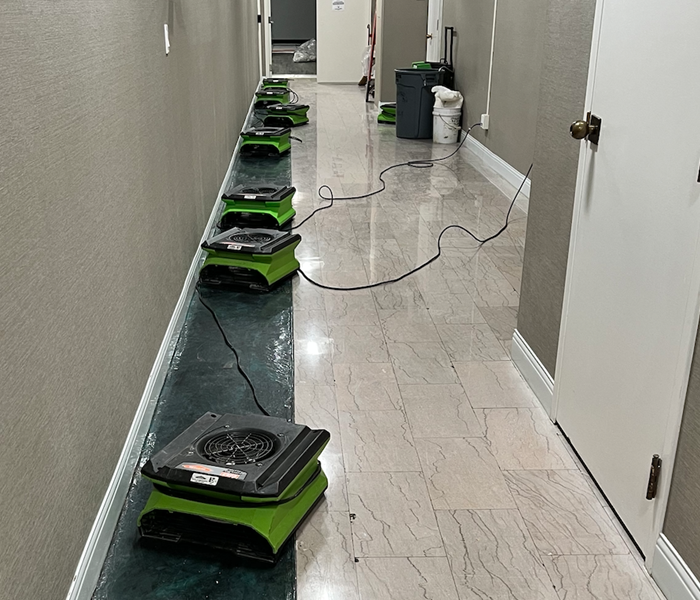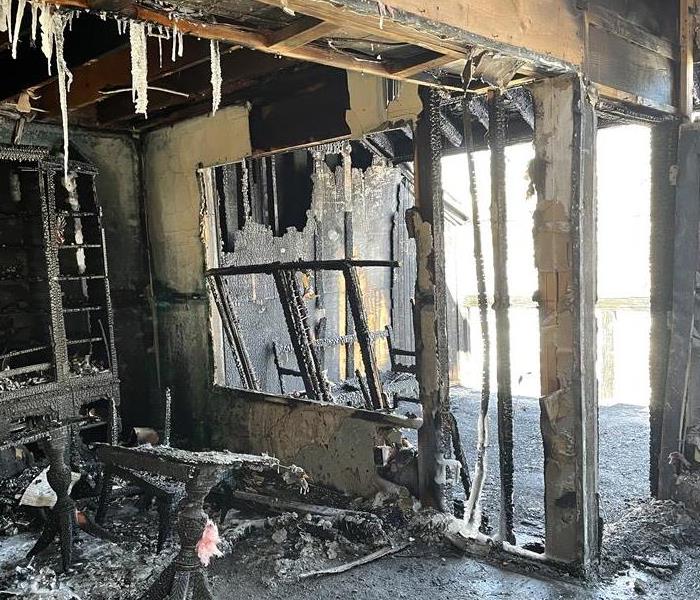Archived Blog Posts
Understanding & Combating Mold
11/28/2022 (Permalink)
 SERVPRO of Parma/Sevens Hills has the training and expertise to handle your mold remediation needs!
SERVPRO of Parma/Sevens Hills has the training and expertise to handle your mold remediation needs!
What is Mold?
Molds are various types of fungi (singular = fungus) that grow in filaments and reproduce by forming spores that can travel through the air. The term mildew is sometimes used to refer to some kinds of mold, particularly mold in the home with a white or grayish color, or mold growing in shower stalls and bathrooms. Mold may grow indoors or outdoors and thrives in damp, warm, and humid environments. Mold can be found in essentially any environment or season.
The most common types of household mold that are found indoors include Cladosporium, Penicillium, Alternaria, and Aspergillus. Stachybotrys chartarum (also known as Stachybotrys atra and sometimes referred to as "black mold") is a greenish-black mold that can also be found indoors, although it is less common than the other types of mold found in homes. Stachybotrys grows on household surfaces that have high cellulose content, such as wood, fiberboard, gypsum board, paper, dust, and lint. There are types of mold that can grow on substances as different as foods and carpet.
Molds reproduce by forming tiny spores that are not visible to the naked eye. Mold spores are very hardy and can survive under conditions in which mold cannot grow, such as in dry and harsh environments. These spores travel through outdoor and indoor air. When the mold spores in the air land on a surface where moisture is present, mold can then start to grow.
Outdoors, molds play a role in the decomposition of organic material such as dead trees, compost, and leaves. They are most common in damp, dark areas or areas of decomposing plant life. Indoors, mold is often found in basements or shower stalls. Indoor mold in residential areas has the potential to cause health problems and can destroy surfaces and objects where it grows.
You Can Control Mold
Inside your home you can control mold growth by:
- Controlling humidity levels;
- Promptly fixing leaky roofs, windows, and pipes;
- Thoroughly cleaning and drying after flooding;
- Ventilating shower, laundry, and cooking areas.
Mold growth, which often looks like spots, can be many different colors, and can smell musty. If you can see or smell mold, a health risk may be present. No matter what type of mold is present, you should remove it. Since the effect of mold on people can vary greatly, either because of the amount or type of mold, you can not rely on sampling and culturing to know your health risk. The best practice is to remove the mold and work to prevent future growth.
MOLD PREVENTION TIPS
Keep humidity levels as low as you can—no higher than 50%–all day long. An air conditioner or dehumidifier will help you keep the level low. Bear in mind that humidity levels change over the course of a day with changes in the moisture in the air and the air temperature, so you will need to check the humidity levels more than once a day.
Be sure your home has enough ventilation. Use exhaust fans, which vent outside your home, in the kitchen and bathroom. Make sure your clothes dryer vents outside your home.
Fix any leaks in your home’s roof, walls, or plumbing so mold does not have moisture to grow.
Clean up and dry out your home thoroughly and quickly (within 24–48 hours) after flooding.
Add mold inhibitors to paints before painting.
Clean bathrooms with mold-killing products.
Remove or replace carpets and upholstery that have been soaked and cannot be dried promptly. Consider not using carpet in rooms or areas like bathrooms or basements that may have a lot of moisture.
If you are in need of mold remediation services, call the pros at SERVPRO of Parma/Seven Hills!
How SERVPRO of Parma/Seven Hills Can Help You Post Storm
11/27/2022 (Permalink)
 SERVPRO of Parma/Seven Hills handles all of your storm damage needs!
SERVPRO of Parma/Seven Hills handles all of your storm damage needs!
At SERVPRO of Parma/Seven Hills, we know that storm damage can be extremely stressful to try to handle. All you want is for your home or business to be back to its pre-storm state, and you may not even know where to start to get back there following a storm. Luckily, we are able to handle anything that Mother Nature throws your way, getting your life back on track following disaster.
We provide Emergency Board Up and Roof Covering/Tarps Services for Parma/Seven Hills homeowners. We're there for you as soon as possible, 24/7/365. We know that storms don't follow a schedule, so whenever disaster hits, we're ready to start the restoration process as soon as we safely can.
Our board up/roof covering service can help you minimize potential damage to your property prior to a storm or help you secure your property after an unexpected disaster occurs. The sooner we are able to secure your home, the less damage you will have.
Here’s a few ways SERVPRO of Parma/Seven Hills can help you if disaster strikes your home or business.
- Hail Damage: Inspection and repair, estimates provided.
- Repairs Following Downed Trees: We help to repair your home following the removal of the tree.
- Ice Backup Damage: If your ice–damaged roof cannot be repaired on the spot, we will temporarily fix it to prevent further damage.
- Tornado Damages: Repairs and cleanup to homes and businesses following catastrophic storms.
- Wind Damage: Provides specialized emergency cleanup and restoration services to bring your property back to normal with minimal interruption.
- Reconstruction and Repair services: Full-service restoration, mitigation, and reconstruction provider for properties damaged by wind, water, fire, hurricane, floods, smoke, mold, and any other disaster.
If you have an emergency causing water damage to your Parma or Seven Hills home, we will be there to help!
How to Handle a Sump Pump Failure
11/22/2022 (Permalink)
 SERVPRO of Parma/Seven Hills has the equipment to handle your water damage restoration needs!
SERVPRO of Parma/Seven Hills has the equipment to handle your water damage restoration needs!
Most houses with a sump pump rely on the pump to keep the basement from flooding. When a big rain storm comes through, the sump pump will really be needed. That's also the time that the power to a neighborhood is most likely going to get knocked out, disabling the sump pump and allowing the basement to flood.
If your sump pump quits working, will you know about it before your basement floods? Do you have a backup in place? Does it work? Are you sure? If you depend on a sump pump to keep your basement from flooding, it's important to have a backup system in place.
It's one of those things that most people don't think about until it's too late. If you want to protect your basement from flooding, get a backup system. There are a few different backup systems available.
Secondary Electric Pump
A secondary electric pump would be a good option to keep your basement from flooding in the event that your primary sump pump failed. The secondary pump would need to be installed a little bit higher in the sump basket than the primary pump. The downside to installing one of these is that if the power to your house went out, the pump would be useless.
Battery Backup
By far, the most common type of backup is a battery powered system. This consists of a big heavy battery that's about the size and shape of a car battery, as well as a backup sump pump that sits in the sump basket a little bit higher than the primary pump. This system will save your basement from flooding if your sump pump fails or your power goes out.
If you already have a backup battery for your sump pump, and it doesn't have a warning to tell you if the battery is dead, you should test it periodically. You can simply unplug your standard sump pump and fill the sump basket with water using a garden hose to test the backup pump.
Hydraulic Pump
Another backup option for your sump basket is to install a pump that is powered by the municipal water pressure coming in to your home. The nice thing about hydraulic pumps is that you don't have to worry about keeping a battery charged all the time, and if you have an extended power outage, you won't have to worry about the pump failing.
The downside to using a hydraulic sump pump is that they're not nearly as powerful. If the water at your home is supplied by a well, a hydraulic backup pump obviously wouldn't be any good, as a power outage would also knock out your well pump.
High Level Alarm
No matter what type of system you have installed, it's a good idea to have a high-level alarm installed in your sump basket. These alarms will sound off if the water level in your sump basket gets too high, and you can buy one for under ten bucks at Home Depot. If you don't have a backup system in place, these alarms will at least tell you that you have a problem and you need to jump to action.
If you want to have a backup sump pump professionally installed, hire a plumber to do so.
If you experience water damage in your basement due to a sump pump failure, be sure to call the pros at SERVPRO of Parma/Seven Hills. We handle the stress of your water damage restoration
Preventing Dryer Fires in Your Parma/Seven Hills Home
11/22/2022 (Permalink)
 SERVPRO of Parma/Seven Hills has the manpower and equipment to handle any size fire damage in your home!
SERVPRO of Parma/Seven Hills has the manpower and equipment to handle any size fire damage in your home!
How to Prevent Dryer Fires
Dryers and washing machines cause around 15,970 fires each year, with dryers causing 92% of them. Dryer fires cause injuries for hundreds of people each year, and on average cause around $238 million in property damage.
Given these numbers—and the fact that more dryer fires occur in the fall and winter—SERVPRO of Parma/Seven Hills wants to be sure that you know how to prevent dryer fires in your home!
Clean Your Lint Filter
Not once a month, or even once a week, lint should be removed from the lint screen with every load of laundry you do. It doesn’t matter if you take this step before or after running a load, but remove any lint from the screen at some point during each use. Not only does this prevent a fire, but it also helps your clothes dry faster as well.
Replace Accordion-Style Ducts
Generally, dryers are equipped with a 4-inch vent in the back, which homeowners or installers connect to an exterior vent with a duct. But not all ducts are created equal.
If you see a plastic or foil accordion-style duct connecting your appliance to the vent, it's a good idea to replace it.
Plastic or foil ducts can sag, which may cause lint to build up in low points. The ridges that these types of ducts have also work as hiding places for lint buildup. It is recommended to use a metal duct, whether it’s flexible or rigid, since it won’t sag, and lint is less likely to accumulate. Use the shortest length possible, and refer to the manual’s instructions.
Inspect Vent and Exhaust Duct Periodically
If you notice that your dryer takes longer to dry laundry than it used to, it’s a clue that there may be a blockage. Another clue: When you’re drying a load, head outside, and take a look at the dryer vent, if you have access to it. Do you see or feel exhaust air? If not, the vent or exhaust duct may be blocked with lint.
The Consumer Product Safety Commission recommends disconnecting the duct from the dryer, cleaning it out, and reconnecting the duct to the dryer and outside vent. While you’re at it, clean behind the dryer and underneath it—lint builds up there, too. In winter, be sure that snow isn’t covering the outdoor vent.
Take Care When Washing Stained Items
Clothes stained with flammable chemicals or substances, such as gas, cooking oil, cleaning agents, or paint thinners, need special care. The CPSC recommends washing the clothing more than once to minimize the volatile chemicals, then hanging to dry. If you must use a dryer, use the lowest heat setting and a drying cycle that concludes with a cool-down period.
In the event that a fire does start, keep the dryer door closed in order to stifle the flames.
If you experience a dryer fire and are in need of fire damage restoration, be sure to call SERVPRO of Parma/Seven Hills!

 24/7 Emergency Service
24/7 Emergency Service


